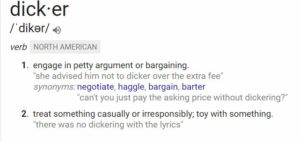One of the questions I’m asked most often is: How do I know when to close my short option trade when it’s a winner?
- You placed a high-probability trade on a calculated risk.
- The trade went as planned. (Maybe even sooner than you expected.)
- You’ve collected 50% or more of possible profits.
Quick answer: Cha-ching! Take the money and move on with no regrets.
For those of you who absolutely, positively, must have a “recipe”, the above answer should suffice. If you use that rule-of-thumb and you have the mindset not to second-guess yourself, you’ll probably be happy with the results. Best of all, you’ll never get caught holding a trade while trying to squeeze out those last few precious dollars by trading it just out of range by one-tick – and have it turn on you and take all your profits back quickly. Don’t think for a minute this can’t happen. It can and does happen, and it usually happens when you least expect it.

A common mistake on winning short option trades is to dicker with your closing order, trying to trade an order just out of reach to make a tiny few extra bucks. (Come on, we all do it – so admit it.) I have seen grown men and women who make well over $50 and $100 an hour at their day job, spend two or more hours trying to make that last $25 on a trade. If you are bored, need something to occupy your time and you can afford to risk 90% of your profits for that “last dollar,” knock yourself out. If you are a sane and reasonably smart business person, make a decision and execute it immediately. This frees you up to concentrate on more profitable and reasonable activities.
My guess is that I just told you something you already know, so forgive me for that please. Now that I’ve told you “the rule”, let me tell about an exception to the rule. At this moment, I hold a number of short NOV17 Soybean CALL options, the strike is 1200, NOV 17 soybeans are trading well OTM at 975.50. These options expire in only 3 (three) days and they are 224.50 cents out-of-the-money. They are trading for 0.125 ($6.25). Here’s how you have to think in this situation: It doesn’t matter if I ask myself “should I have exited earlier?” The truth is I woke up this morning and, however this happened, I only should be dealing with what is true right now, today, this minute. So my decision in this minute is to leave them alone to expire worthless this Friday (3 days away.) Why? It’s a no-brainer; they are 225 cents OTM with 3 days to go, I’m not going to spend a $3.50 commission to dodge an event (the trade going bad on me) that just isn’t going to happen.
A seasoned experienced trader would tell you in a New York minute that wasting time on “what do do” here is foolish. Move on. So why do I even bother discussing such a petty thing here on this blog? So traders that are not yet “seasoned and experienced traders” can learn. Many new traders are learning to Time-Farm in a vacuum; they simply don’t know anyone else who does these types of trades.
Now I’ll close this article out with one more thought: Treat your Time-Farming trades as owning your own business. You are the CEO and you must make responsible decisions or you will go out of business. When you can make a decision that puts profits on your bottom line, gets you out of risk (though it might be small, the gain versus risk has been reduced to the diminishing returns,) and that frees up the worth of your account to make more good trades – then you are a responsible CEO. Learn to listen to your own advice. You’ll know when you are being prudent and when you are being greedy. In investing, hope is not a strategy (Well, it can be – but it’s too often expensive.)
In life as well as in your investments – when you learn to make good decisions, you get to use that experience again and again for all your days. One of my mentors used to remind me of this John Lennon quote: “Experience is what you get, when you didn’t get what you wanted.” He also reminded me not to let other people live in my head rent-free. Good trading to you – Don


